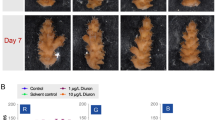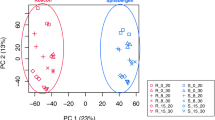Abstract
Genes involved in defense mechanisms can be used as efficient biomarkers of physiological changes in organisms caused by both endogenous and exogenous stress. Thus, the expression levels of such genes serve as a critical ‘early warning system’ for the environmental assessment and health of biological organisms. In this study, the transcription levels of Hsp70 and vBPO in Undaria pinnatifida sporophytes were quantitatively compared between two distinct natural populations collected from uncontaminated Mijo (Namhae, Korea) and industrially-polluted Myodo Is. (Yeosu, Korea) in order to verify their potential as biomarker genes and the applicability of this macroalga for assessing the health status of a local marine ecosystem. The results found that the two tested genes were highly expressed in the Myodo population. The results suggest that U. pinnatifida itself and the selected two genes could be applicable to monitoring of marine environments in coastal regions.
Similar content being viewed by others
References
Peakall, D. B. The role of biomarkers in environmental assessment (1). Introduction. Ecotoxicology 3, 157–160 (1994).
Depledge, M. H. & Fossi, M. C. The role of biomarkers in environmental assessment (2). Invertebrates. Ecotoxicology 3, 161–172 (1994).
Cooper, R. et al. GFS, a preparation of Tasmanian Undaria pinnatifida is associated with healing and inhibition of reactivation of Herpes. BMC Complement Altern. Med. 2, 11 (2002).
Maruyama, H., Tamauchi, H., Iizuka, M. & Nakano, T. The role of NK cells in antitumor activity of dietary fucoidan from Undaria pinnatifida sporophylls (Mekabu). Planta Med. 72, 1415–1417 (2006).
Hayashi, K. et al. Defensive effects of a fucoidan from brown alga Undaria pinnatifida against herpes simplex virus infection. Int. Immunopharmacol. 8, 109–116 (2008).
Khan, M. N. et al. Isolation of two anti-inflammatory and one pro-inflammatory polyunsaturated fatty acids from the brown seaweed Undaria pinnatifida. J. Agric. Food Chem. 55, 6984–6988 (2007).
Bukau, B. & Horwich, A. L. The Hsp70 and Hsp60 chaperone machines. Cell 92, 351–366 (1998).
Butler, A. & Carter-Franklin, J. N. The role of vanadium bromoperoxidase in the biosynthesis of halogenated marine natural products. Nat. Prod. Rep. 21, 180–188 (2004).
Sorensen, J. G., kristensen, T. N. & Loeschke, V. The evolutionary and ecological role of heat shock proteins. Ecology Letters 6, 1025–1037 (2003).
Boutet, I. et al. Molecular identification and expression of heat shock cognate 70 (hsc70) and heat shock protein 70 (hsp70) genes in the Pacific oyster Crassostrea gigas. Cell Stress Chaperones 8, 76–85 (2003).
Franzellitti, S. & Fabbri, E. Differential HSP70 gene expression in the Mediterranean mussel exposed to various stressors. Biochem. Biophys. Res. Commun. 336, 1157–1163 (2005).
Vayda, M. E. & Yuan, M. L. The heat shock response of an antarctic alga is evident at 5 degrees C. Plant Mol. Biol. 24, 229–233 (1994).
Lewis, S., Donkin, M. E. & Depledge, M. H. Hsp70 expression in Enteromorpha intestinalis (Chlorophyta) exposed to environmental stressors. Aquat. Toxicol. 51, 277–291 (2001).
Ritter, A. et al. Copper stress proteomics highlights local adaptation of two strains of the model brown alga Ectocarpus siliculosus. Proteomics 10, 2074–2088 (2010).
Baden, D. G. & Corbett, M. D. Bromoperoxidases from Penicillus capitatus, Penicillus lamourouxii and Rhipocephalus phoenix. Biochem. J. 187, 205–211 (1980).
Colin, C. et al. Vanadium-dependent iodoperoxidases in Laminaria digitata, a novel biochemical function diverging from brown algal bromoperoxidases. J. Biol. Inorg. Chem. 10, 156–166 (2005).
Shimonishi, M. et al. Cloning and expression of the gene for a vanadium-dependent bromoperoxidase from a marine macro-alga, Corallina pilulifera. FEBS Lett. 428, 105–110 (1998).
Roeder, V. et al. Identification of stress gene transcripts in Laminaria digitata (Phaeophceae) protoplast cultures by expressed sequence tag analysis. J. Phycol. 41, 1227–1235 (2005).
Chan, C. X., Ho, C. L. & Phang, S. M. Trends in seaweed research. Trends Plant Sci. 11, 165–166 (2006).
Lluisma, A. O. & Ragan, M. A. Expressed sequence tags (ESTs) from the marine red alga Gracilaria gracilis. J. Appl. Phycol. 9, 287–293 (1997).
Crepineau, F. et al. Characterisation of complementary DNAs from the expressed sequence tag analysis of life cycle stages of Laminaria digitata (Phaeophyceae). Plant Mol. Biol. 43, 503–513 (2000).
Nikaido, I. et al. Generation of 10,154 expressed sequence tags from a leafy gametophyte of a marine red alga, Porphyra yezoensis. DNA Res. 7, 223–227 (2000).
Wong, T. K. M. et al. Analysis of expressed sequence tags from Sargassum binderi (Phaeophyta). J. Phycol. 43, 528–534 (2007).
Collen, J. et al. Expression profiling of Chondrus crispus (Rhodophyta) after exposure to methyl jasmonate. J. Exp. Bot. 57, 3869–3881 (2006).
Collen, J., Guisle-Marsollier, I., Leger, J. J. & Boyen, C. Response of the transcriptome of the intertidal red seaweed Chondrus crispus to controlled and natural stresses. New Phytol. 176, 45–55 (2007).
Dittami, S. M. et al. Global expression analysis of the brown alga Ectocarpus siliculosus (Phaeophyceae) reveals large-scale reprogramming of the transcriptome in response to abiotic stress. Genome Biol. 10, R66 (2009).
Woo, S. et al. Differential gene expression in a red alga Gracilaria textorii (Suringar) Hariot (Gracilariales, Florideophyceae) between natural populations. Mol. Cell. Toxicol. 4, 199–204 (2008).
Hyun, S., Lee, T., Lee, C. H. & Park, Y. H. The effects of metal distribution and anthropogenic effluents on the benthic environment of Gwangyang Bay, Korea. Mar. Pollut. Bull. 52, 113–120 (2006).
Kim, Y. S. et al. Organochlorine pesticides in the sediment core of Gwangyang bay, South Korea. Arch. Environ. Contam. Toxicol. 54, 386–394 (2008).
Kim, Y. S. et al. The characterization of PCDDs, PCDFs and coplanar PCBs during the past 50 years in Gwangyang Bay, South Korea. J. Hazard. Mater. 154, 756–765 (2008).
Ahn, J. S. et al. Optimization of RNA purification method from a brown alga Ecklonia cava Kjellman (Laminariales, Phaeophyceae). Algae 19, 123–127 (2004).
Author information
Authors and Affiliations
Corresponding author
Rights and permissions
About this article
Cite this article
Woo, S., Ko, Y.W., Kim, J.H. et al. Changes in gene expression in the brown alga Undaria pinnatifida (Harvey) Suringar (Laminariales, Pheophyceae) between natural populations. Toxicol. Environ. Health Sci. 3, 91–96 (2011). https://doi.org/10.1007/s13530-011-0083-4
Accepted:
Published:
Issue Date:
DOI: https://doi.org/10.1007/s13530-011-0083-4




